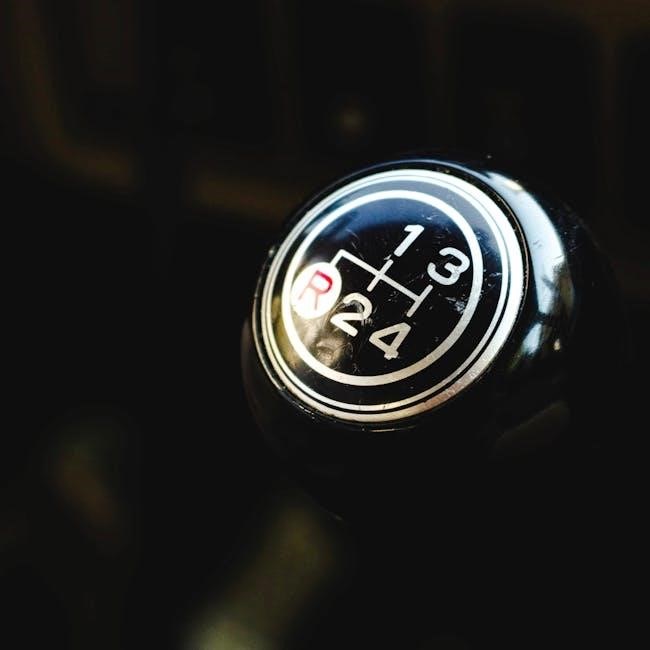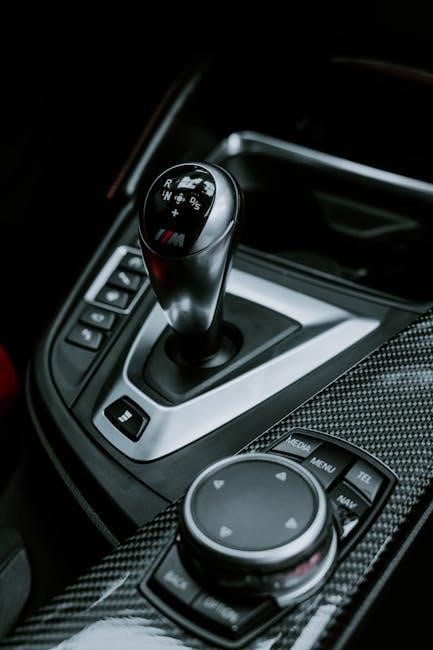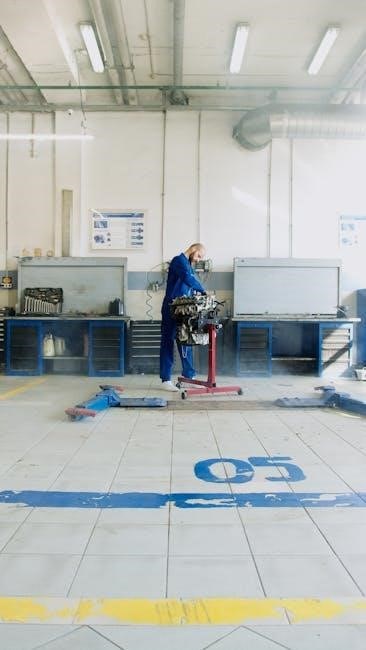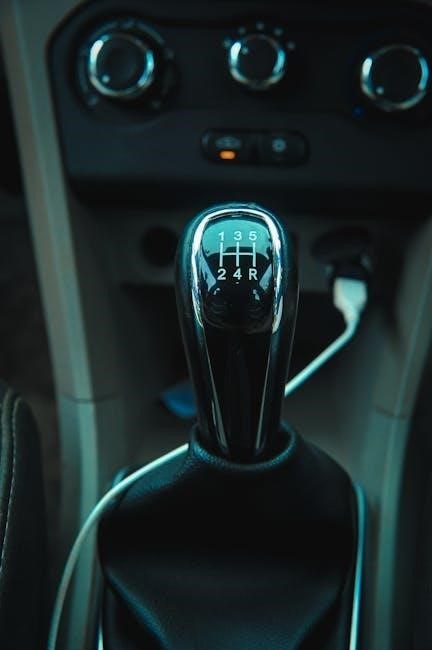Converting a manual to an automatic transmission involves replacing the manual gearbox with an automatic system for easier driving․ This process enhances convenience and reduces driver effort, especially in heavy traffic conditions․ It requires specific components like an automatic transmission, adapters, and often reprogramming the vehicle’s computer system․ While it offers benefits like smoother acceleration and reduced clutch wear, the conversion can be complex and costly, depending on the vehicle model and year․ Proper planning and professional expertise are often recommended to ensure a successful transition․
What is a Transmission Conversion?
A transmission conversion involves replacing a vehicle’s manual gearbox with an automatic transmission system․ This process allows drivers to switch from a clutch-based, gear-shifting mechanism to an automatic system that changes gears without manual input․ The conversion typically requires installing a compatible automatic transmission, along with necessary adapters, linkages, and electronic controls․ It may also involve reprogramming the vehicle’s computer to ensure proper functionality․ The goal is to achieve smoother, hands-free gear shifting, making driving easier and more convenient, especially in heavy traffic or hilly terrains; Proper planning and professional expertise are often essential for a successful conversion․
Why Convert from Manual to Automatic?
Converting from a manual to an automatic transmission offers enhanced driving convenience, especially in heavy traffic or hilly areas․ Automatic transmissions eliminate the need for constant clutch engagement and manual gear shifting, reducing driver fatigue․ This conversion is particularly beneficial for individuals who find manual driving challenging or prefer a smoother, hands-free experience․ Additionally, it can improve vehicle accessibility for drivers with physical limitations․ The switch also reduces wear on the clutch and related components, potentially lowering long-term maintenance costs․ Overall, it provides a more comfortable and stress-free driving experience for many motorists․
Overview of the Conversion Process
Converting a manual transmission to an automatic involves several key steps․ First, drain the transmission fluid and disconnect the necessary components, such as the clutch and linkages․ Next, remove the manual transmission and prepare the vehicle for the automatic unit․ This includes installing the new transmission, torque converter, and shifter mechanism․ Reconnecting the driveshaft, cooling lines, and electrical systems follows․ Finally, refill the transmission fluid and perform initial testing to ensure proper function․ The process requires careful planning and mechanical expertise, especially for modern vehicles with complex computer systems․ Professional assistance is often recommended to avoid complications․

Understanding Manual and Automatic Transmissions
Manual transmissions require driver input to change gears using a clutch and gearshift, offering control and efficiency․ Automatic transmissions shift gears automatically, providing ease and convenience, especially in traffic․ Both systems transfer power from the engine to the wheels but differ in operation and driver involvement․
How Manual Transmissions Work
A manual transmission requires the driver to manually change gears using a clutch pedal and gearshift․ The clutch disconnects the engine from the transmission, allowing the driver to shift gears smoothly․ The gearshift selects the desired gear ratio, providing control over speed and torque․ As the driver presses the clutch and moves the gearshift, the transmission engages the selected gear, enabling the vehicle to accelerate or decelerate accordingly․ This system relies on driver input and coordination, offering precise control and efficiency compared to automatic systems․
How Automatic Transmissions Work
An automatic transmission uses a torque converter to transfer engine power to the gears, eliminating the need for manual clutch engagement․ The transmission relies on hydraulic pressure and electronic controls to shift gears automatically, based on throttle input, vehicle speed, and engine RPM․ Planetary gear sets within the transmission allow for smooth transitions between gears, providing seamless acceleration․ Modern automatic transmissions are controlled by a Transmission Control Module (TCM), which optimizes shifting for efficiency and performance․ This system simplifies driving, especially in heavy traffic, by removing the need for manual gear changes․
Key Differences Between Manual and Automatic Transmissions
Manual transmissions require driver engagement with a clutch pedal and gearshift, offering control over gear changes, while automatic transmissions shift gears automatically via a torque converter․ Manuals typically provide better fuel efficiency, lower production costs, and a more immersive driving experience․ Automatics, however, are more convenient, especially in heavy traffic, as they eliminate the need for manual shifting․ Automatics are generally heavier and more complex, with higher maintenance costs over time․ The choice between the two often comes down to personal preference, driving conditions, and the desired balance of control, convenience, and performance․
Assessing Feasibility for Conversion
Check if your vehicle is compatible with an automatic transmission․ Evaluate costs and potential challenges, such as specialized tools or professional expertise required for a smooth conversion․
Is Conversion Possible for Your Vehicle?
Determining if a manual-to-automatic conversion is feasible depends on your vehicle’s make, model, and year․ Modern vehicles with advanced computer systems may require reprogramming, while older models might be simpler․ Compatibility of the automatic transmission with your engine and drivetrain is crucial․ Researching forums or consulting professionals can provide insights specific to your vehicle․ Additionally, availability of conversion kits and parts plays a significant role in assessing feasibility․ Ensure your vehicle’s specifications align with the conversion requirements to avoid complications․
Cost Considerations
Manual to automatic transmission conversion costs vary widely, ranging from $1,500 to $5,000 or more, depending on the vehicle and transmission type․ Factors include the cost of the automatic transmission, adapters, and labor․ Older vehicles may be more cost-effective, while modern cars with advanced systems require additional components like electronic controls․ Professional installation can add significant expenses, and custom fabrication may increase costs further․ Budgeting for potential modifications, such as reprogramming the vehicle’s computer, is essential․ Researching specific kits and consulting specialists can help estimate the total investment accurately․
Challenges and Potential Risks
Converting a manual to an automatic transmission presents several challenges․ Compatibility issues between the engine and automatic transmission can arise, requiring custom adapters or modifications․ Modern vehicles with electronic controls may need complex reprogramming, which can be difficult without specialized tools․ There’s also a risk of costly errors if the conversion isn’t done correctly, potentially leading to transmission failure or other mechanical issues․ Additionally, the process can be labor-intensive and time-consuming, especially for those without experience․ These risks highlight the importance of thorough planning and professional assistance to ensure a successful conversion․

Gathering Necessary Components
Gathering the necessary components for a manual to automatic transmission conversion involves selecting the right automatic transmission, adapter plate, torque converter, and additional parts like transmission mounts and shifters․ Conversion kits can simplify the process․
Automatic Transmission Options
Selecting the right automatic transmission is crucial for a successful conversion․ Options include remanufactured units, universal models, or vehicle-specific transmissions․ Compatibility with the existing drivetrain and electrical systems must be verified․ Modern vehicles may require specialized automatic transmissions designed for their specific make and model․ Conversion kits often include pre-configured transmissions to simplify the process․ However, consulting with a professional is advisable, especially for complex modern systems․ Each option has its pros and cons, and proper selection ensures a smooth and reliable conversion․ Always ensure the transmission is compatible with your vehicle’s specifications․
Adapters and Conversion Kits
Adapters and conversion kits are essential for transitioning from manual to automatic transmission; These kits typically include specialized adapters to mount the automatic transmission securely․ They often feature custom-engineered components to ensure compatibility with the vehicle’s drivetrain․ Conversion kits may also include necessary hardware like crossmembers, shift linkages, and electrical connectors․ Universal kits are available, but vehicle-specific solutions are recommended for seamless integration․ Adapters help align the transmission with the engine and driveshaft, ensuring proper fitment and functionality․ They are critical for maintaining the integrity of the vehicle’s mechanical systems during the conversion process․ Proper installation is key to avoiding future mechanical issues․
Additional Parts Required
Beyond the transmission and adapters, several other components are necessary for a successful conversion․ A torque converter is essential to replace the manual clutch system, ensuring smooth power delivery․ A transmission cooler may be required to manage heat, especially in high-stress driving conditions․ Wiring harnesses and electronic control modules are often needed to integrate the automatic transmission with the vehicle’s electrical systems․ Additionally, the driveshaft may need modification to accommodate the new transmission’s dimensions and rotation speed․ These components ensure compatibility and proper functionality, making them critical to the conversion process․ Proper selection and installation are vital for reliability and performance․

Preparation for the Conversion
Preparation involves gathering tools, securing the vehicle, and ensuring a clean workspace․ Proper planning and organization are crucial for a smooth and efficient conversion process․
Draining Fluids and Disconnecting Components
Draining transmission fluid ensures a clean workspace and prevents spills․ Disconnecting components includes removing linkages, clutch release bearings, and electrical connectors․ Proper preparation is essential for a successful conversion․
Removing the Manual Transmission
Removing the manual transmission involves disconnecting the gearshift, clutch, and linkages․ Draining the transmission fluid is essential to prevent spills․ The transmission is then unbolted from the engine and carefully lifted out using a jack or transmission jack․ Proper support and safety measures are crucial to avoid damage or injury․ For older models, this process may be straightforward, but modern vehicles often require specialized tools and expertise․ Ensure all components are labeled for reinstallation, and consider professional assistance if unsure about the process․ This step is critical for a smooth conversion to an automatic system․
Preparing the Vehicle for Automatic Transmission Installation
After removing the manual transmission, the vehicle must be prepared for the automatic system․ This includes inspecting and replacing the crossmember, driveshaft, and any worn components․ The engine mounts should be checked and replaced if necessary to support the new transmission․ A torque converter specific to the automatic transmission must be installed, ensuring proper alignment with the crankshaft․ Additionally, the vehicle’s electrical system may need modifications to accommodate the automatic transmission’s controls․ Proper preparation ensures a smooth installation process and optimal performance of the new automatic transmission․

Installing the Automatic Transmission
Mount the automatic transmission, ensuring proper alignment with the engine․ Connect the torque converter to the crankshaft and secure it․ Attach the shifter and linkages for control․
Mounting the Automatic Transmission
Mounting the automatic transmission requires precise alignment with the engine and frame․ Use an adapter plate to secure the transmission, ensuring compatibility with your vehicle’s make and model․ Attach the torque converter to the crankshaft, verifying proper engagement․ Bolt the transmission firmly, checking alignment to prevent vibration or damage․ Modify the crossmember and transmission tunnel if necessary for a flush fit․ Ensure the driveshaft length matches the new transmission configuration․ Proper mounting ensures smooth operation and longevity of the automatic system․
Connecting the Torque Converter
Connecting the torque converter involves aligning it with the automatic transmission’s input shaft and securing it to the engine’s crankshaft․ Ensure the converter is fully seated and engaged with the transmission hub․ Proper alignment prevents vibration and ensures smooth power transfer․ Use the correct bolts and torque specifications to secure the converter․ Check the pilot bearing for proper fitment and replace if necessary․ Verify compatibility between the torque converter and the automatic transmission to ensure optimal performance․ Proper installation is critical for avoiding premature wear and ensuring reliable operation of the automatic system․
Hooking Up the Shifter and Linkages
Hooking up the shifter and linkages involves installing the automatic shifter assembly and connecting it to the transmission․ Remove the manual shifter and install the automatic shifter, ensuring proper alignment and mounting․ Adjust the linkage system to connect the shifter to the transmission’s gear selector․ This step requires precise alignment to ensure smooth gear shifts․ Install any necessary adapters or brackets to accommodate the new shifter․ Test the shifter’s operation to confirm it engages gears correctly․ Proper installation ensures intuitive control over the automatic transmission, enhancing driving comfort and convenience․
Reconnecting and Testing
Reconnect the driveshaft and cooling lines, ensuring all connections are secure․ Refill the transmission fluid to the recommended level․ Perform initial tests to check for leaks, smooth shifting, and proper engagement of gears․
Reconnecting Driveshaft and Cooling Lines
Reconnecting the driveshaft and cooling lines is a critical step in the conversion process․ Ensure the driveshaft is properly aligned and securely reattached to the new automatic transmission; Cooling lines must be reconnected to prevent overheating, especially if the automatic transmission requires a dedicated cooler․ Use appropriate adapters or fittings to maintain a leak-free connection․ Double-check all couplings and hoses for tightness before proceeding․ Proper alignment and secure connections are essential to avoid vibration or damage during operation․ If unsure, consult a professional to ensure everything is correctly reinstalled and functioning smoothly․
Refilling Transmission Fluid
Refilling transmission fluid is essential after installing an automatic transmission․ Use the type specified in your vehicle’s manual to ensure compatibility․ Fill the fluid to the recommended level using a funnel to prevent spills․ Replace the dipstick or filler cap securely․ Start the engine, shift through all gears, and check for leaks around the transmission pan or cooler lines․ Allow the vehicle to idle for a few minutes to circulate the fluid․ Finally, test drive the vehicle to ensure smooth operation and monitor fluid levels to avoid overheating or damage to the transmission․
Initial Testing and Adjustments
After refilling the transmission fluid, start the engine and check for leaks around the transmission pan, cooler lines, and connections․ Allow the vehicle to idle for a few minutes to circulate the fluid․ Test drive slowly, shifting through all gears to ensure smooth engagement and acceleration․ Monitor the transmission’s behavior under various conditions, such as uphill climbs or sudden acceleration․ If the transmission hesitates or slips, adjustments may be needed to the torque converter or shifter linkage․ Repeat the process until the transmission operates seamlessly․ Always refer to the vehicle’s manual for specific testing procedures․
Electrical and Computer Systems
Modern vehicles require reprogramming the computer system after a manual-to-automatic conversion․ Ensure compatibility with electronic controls and update the ECU for smooth transmission operation and optimal performance․
Understanding Electronic Controls
Modern vehicles rely on electronic controls to manage transmission operations․ Automatic transmissions use sensors and solenoids to regulate gear shifts, torque converter engagement, and fluid pressure․ The Transmission Control Module (TCM) oversees these functions, ensuring smooth and efficient operation․ When converting from manual to automatic, integrating the TCM with the vehicle’s existing computer systems is crucial․ Reprogramming the Engine Control Unit (ECU) may also be necessary to synchronize engine and transmission performance․ Proper electronic control setup is vital for optimal driving experience and to prevent issues like delayed shifting or insufficient power delivery․
Reprogramming the Vehicle’s Computer
Reprogramming the vehicle’s computer is crucial during a manual to automatic transmission conversion․ Modern vehicles rely on sophisticated electronic systems to control transmission functions, including gear shifts and torque converter engagement․ The Transmission Control Module (TCM) and Engine Control Unit (ECU) must be updated to recognize and manage the new automatic transmission․ This process typically requires specialized software and tools, often available at dealerships or through professional mechanics․ Reprogramming ensures compatibility and optimal performance, preventing issues like delayed shifting or incorrect gear engagement․ DIY solutions exist but may pose risks if not done correctly, emphasizing the importance of professional expertise for a smooth transition․
Ensuring Compatibility with Modern Systems
Ensuring compatibility with modern systems is vital for a successful manual to automatic transmission conversion․ Modern vehicles feature advanced computerized components, including sensors, solenoids, and wiring harnesses, which must integrate seamlessly with the new automatic transmission․ Compatibility issues can arise, particularly with older vehicles, where the existing hardware and software may not support the automatic system․ Adapters, custom wiring, and updated firmware may be necessary to bridge these gaps․ Additionally, consulting with specialists or using conversion kits designed for specific vehicle models can help mitigate compatibility challenges, ensuring the transmission operates in harmony with the vehicle’s electronic systems for optimal performance and reliability․

Pros and Cons of Conversion
Converting to automatic offers convenience, reduced driver fatigue, and smoother acceleration, ideal for urban driving; However, it may increase costs, reduce fuel efficiency, and require complex modifications․
Advantages of an Automatic Transmission
An automatic transmission offers unparalleled convenience, eliminating the need for manual gear shifting․ This reduces driver fatigue, especially in heavy traffic or stop-and-go situations․ Smooth acceleration enhances comfort and performance, making it ideal for urban driving․ Automatics also provide better low-speed control, reducing the risk of stalling․ Additionally, they often come with features like cruise control and driver-assist systems, which modern drivers appreciate․ For those less experienced or with physical limitations, an automatic transmission simplifies the driving experience․ It also reduces mechanical wear on the clutch and other components, potentially extending the vehicle’s lifespan․ This makes it a practical choice for many motorists․
Disadvantages of Converting to Automatic
Converting to an automatic transmission can be costly and complex, especially for modern vehicles with advanced computer systems․ The process often requires reprogramming the vehicle’s computer, which can be challenging and expensive; Additionally, automatic transmissions are generally heavier and may reduce fuel efficiency compared to manuals․ The conversion also removes the driver engagement and control that many enthusiasts enjoy with manual gear shifting․ Furthermore, older vehicles may not see significant benefits, and the cost of parts and labor can outweigh the advantages․ This makes the conversion less practical for some drivers who value performance and cost-effectiveness․
Maintenance and Upkeep
Regular maintenance is crucial after conversion․ Check transmission fluid levels, inspect for leaks, and monitor performance․ Schedule regular servicing to ensure optimal functionality and longevity․
Post-Conversion Maintenance Tips
After converting to an automatic transmission, regular maintenance is essential․ Check transmission fluid levels monthly and change it as recommended․ Inspect for any signs of leaks around the torque converter and pan gasket․ Ensure the transmission filter is replaced during routine servicing to maintain optimal performance․ Monitor the vehicle’s dashboard for any warning lights indicating transmission issues․ Additionally, avoid extreme temperatures and towing heavy loads without proper cooling upgrades․ Always follow the manufacturer’s maintenance schedule for the newly installed automatic transmission to ensure reliability and prevent premature wear․
Monitoring Transmission Health
Regularly monitoring the transmission’s health is crucial after a manual to automatic conversion․ Check the transmission fluid level monthly and ensure it’s clean and at the recommended level․ Look for signs of leaks around the torque converter, pan gasket, and cooler lines․ Use a scan tool to check for any error codes in the transmission control module․ Avoid driving in extreme temperatures or towing heavy loads without proper cooling upgrades․ Listen for unusual noises, such as slipping or clunking, which may indicate issues․ Schedule periodic inspections with a qualified mechanic to ensure the transmission operates smoothly and efficiently․

Troubleshooting Common Issues
Common issues after conversion include leaks, slipping, or delayed engagement․ These often result from improper installation, low fluid levels, or worn components․ Regular checks and adjustments are essential․
Diagnosing Problems After Conversion
Diagnosing issues post-conversion involves checking for signs like slipping, erratic shifting, or unusual noises․ Low transmission fluid levels or contamination can cause problems․ Faulty sensors or wiring may disrupt electronic controls, requiring reprogramming․ Leaks from the torque converter or cooler lines are common, needing immediate attention․ A thorough inspection of connections and components ensures accurate troubleshooting․ Professional diagnostic tools may be necessary for complex issues, especially in modern vehicles with advanced computer systems․ Regular maintenance can help identify and resolve problems early, preventing costly repairs․
Addressing Leaks, Slipping, or Delayed Engagement
Leaks, slipping, or delayed engagement after conversion require immediate attention․ Inspect the torque converter and cooler lines for signs of leakage, as these are common sources․ Slipping may indicate low transmission fluid levels, contaminated fluid, or worn clutch packs․ Delayed engagement could stem from faulty solenoids or sensors․ Proper fluid levels and clean transmission fluid are crucial for smooth operation․ If issues persist, professional diagnostic tools may be needed to identify and resolve problems․ Regular maintenance, such as fluid checks and filter replacements, can help prevent these complications․ Addressing these issues promptly ensures optimal performance and extends the transmission’s lifespan․
